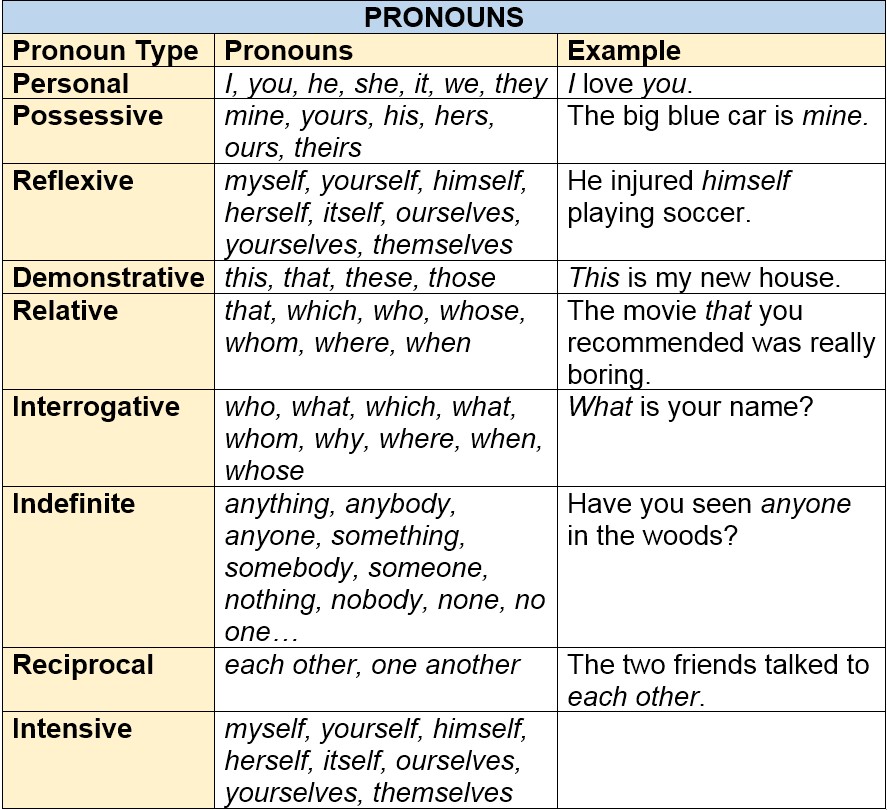Download 
Basic English Grammar Book for Students PDF File
DEFINITION: A pronoun is defined as a word or phrase that may take place of a noun or noun phrase. The replaced noun or noun phrase is known as the pronoun’s antecedent.
TYPES OF PRONOUNS:
There five types of pronouns:
- Personal pronouns
- Possessive pronouns
- Reflexive pronouns
- Demonstrative pronouns
- Relative pronouns
- Interrogative pronouns
- Indefinite pronouns
- Reciprocal pronouns
- Intensive (or Emphatic) pronouns
Personal Pronouns
Personal pronouns refer to particular persons or things. Personal pronoun describes the person speaking (I, me, we, us), the person spoken to (you), or the person or thing spoken about (he, she, it, they, him, her, them).
We differentiate SUBJECT and OBJECT personal pronouns. SUBJECT personal pronouns function as the subject of the main verb hence ‘subject’ pronouns. SUBJECT pronouns represent Nominative case forms of pronouns while OBJECT personal pronouns represent Accusative case forms of pronouns. OBJECT personal pronouns are used as the object of a verb, preposition or infinitive phrase, hence ‘object’ pronouns.
EXAMPLE:
Possessive Pronouns
Possessive pronouns indicate close possession or ownership or relationship of a thing/person to another thing/person. Possessive pronouns can refer back to a noun and must agree with it in gender and number. Possessive pronouns never take apostrophes.
A possessive pronoun is used to avoid repeating information that has already been made clear. Thus, pronouns make sentences less confusing.
EXAMPLE:
Look at these bags. Mine is the red one.
Peter found his wallet but Jane couldn’t find hers.
Steve and Mary don’t like your house. Do you like theirs?
Possessive adjectives (my, your, her, his, its, our, your, their) may be confused with possessive pronouns. Possessive adjectives modify noun in terms of possession. Both possessive adjective and possessive pronoun show possession or ownership, but possessive adjective is used (with noun) to modify the noun while possessive pronoun is used instead (in place of) a noun.
EXAMPLE:
The boy lost his hat. (possessive adjective)
All red hats are good. His are terrible. (possessive pronoun)
Both possessive pronoun and possessive adjective refer back to a noun and must agree with it in gender and number.
EXAMPLE of possessive adjective:
Incorrect: The boy lost their hats.
Correct: The boy lost his hat.
EXAMPLE of possessive pronoun:
Reflexive Pronoun
A reflexive pronoun is a pronoun that is preceded by the adverb, adjective, pronoun, or noun to which it refers, so long as that antecedent is located within the same clause. One could say that reflexive pronouns indicate that the person performing the action of the verb is also the recipient of the action.
A reflexive pronoun ends with “-self” or “-selves” and refers to another noun or pronoun in the sentence (usually the subject of the clause). The reflexive pronouns are myself, yourself, herself, himself, itself, ourselves, yourselves and themselves.
EXAMPLE:
I was in a hurry, so I typed the document myself.
She’ll have to drive herself today.
John cut himself on the sharp knife.
John and Steve bought drinks for themselves.
The exam itself wasn’t difficult, but the examiner was too strict.
Demonstrative pronouns
Demonstrative pronouns indicate specific persons, places, or things. Demonstrative Pronouns are used to show or identify one or a number of nouns that may be far or near in distance or time. Demonstrative pronouns can be singular or plural. They are only four in number – this, that, these and those. These pronouns point to thing or things in short distance/time or long distance/time.
EXAMPLE:
This is a beautiful house.
That is a great idea!
I see so many wonderful shoes in the store. Would you like to buy these?
Those were the days!
Demonstrative pronouns often function as adjectives. In this case, noun comes right after the demonstrative: this, that, these, or those. Such demonstratives agree with the noun they precede in number.
EXAMPLE:
This book is great!
Could you give me that bag over there?
These houses are big.
Relative pronouns
A relative pronoun is a pronoun that introduces a relative clause. It is called a “relative” pronoun because it “relates” to the word that its relative clause modifies. Relative pronouns introduce subordinate clauses functioning as adjectives and refer back to the noun (also a noun phrase) or pronoun that the clause modifies.
The most common relative pronouns are: who, whom, whose, which, and that. Who functions as the subject of a clause or sentence, while whom functions as the object of a verb or preposition. Who and whom are used for people. Whose is used to show possession and can be used for both people and things. Which is used for things. That is used for people and things. In some situations, the words what, when, and where can also function as relative pronouns. Rules for using relative clauses:
- Relative clauses are introduced by relative pronouns. The relative pronoun can function as a possessive pronoun, an object, or a subject.
- When relative pronouns introduce restrictive relative clauses, no comma is used to separate the restrictive clause from the main clause.
EXAMPLE:
She will choose the color which looks good on her.
Here, which is joining the two related clauses about choosing a color and a color which would look good on her.
It is the girl who got first place in the race.
The man whom I met yesterday is our new neighbor.
It is the boy whose uncle is a police officer.
The athlete who won the race trained hard.
The store on the corner, where we usually buy all our groceries,
was robbed.The vase that was on the table is missing.
Interrogative pronouns
Interrogative pronouns introduce interrogative sentences (question and indirect questions). The interrogative pronoun represents the thing that we don’t know. Thus, they are used to ask questions about a person or object that we do not know about.
The main interrogative pronouns: what, which, who, whom, whose.

What is used to ask questions about people or objects.
EXAMPLE:
What is your name?
What is the meaning of life?
Which is used to ask questions about people or objects.
EXAMPLE:
Which way should I go?
Which car do you prefer?
Who is used to ask questions about people?
EXAMPLE
Who told you that?
Who is coming to the party?
I asked him who would be at the party.
Whom is used to ask questions about people. It functions as an object of the sentence.
EXAMPLE:
Whom do you prefer to vote for?
To whom should I give my message?
Whose is used to ask questions about people or objects, always related to possession.
EXAMPLE:
Whose iPhone is this?
I wonder whose car is parked in front of our house.
Sometimes we use the suffix -ever to make compounds from some of interrogative pronouns. Interrogative pronouns with suffix -ever are used for emphasis, often to show confusion or surprise. Thus, we have: whatever, whatsoever, whichever, whoever, whosoever, whomever, whomsoever, whosoever.
Indefinite pronouns
Indefinite pronouns are pronouns that refer to one or more unspecified (or non-specific) objects, beings, or places. They are called “indefinite” because they do not indicate the exact object, being, or place to which they refer.
Typical indefinite pronouns are: all, another, any, anybody/anyone, anything, each, everybody/everyone, everything, few, many, nobody, none, one, several, some, somebody/someone.
Most indefinite pronouns are always singular and take a singular verb. Some are always plural and take a plural verb.
Indefinite pronouns include partitives, universals, and quantifiers. Many indefinite pronouns can also function as adjectives (determiners).
EXAMPLE:
Somebody ate my chocolate!
Many have expressed their views.
A few of the customers were not satisfied with the service.
All were present at the meeting.
None of them showed up.
Is anybody here?
Either one is a good choice.
Each soccer player will receive a medal. (used as an adjective before a noun phrase)
Reciprocal pronouns
Reciprocal pronouns are used when two or more nouns are doing or being the same to one another. They are used when two subjects act in the same way towards each other, or, more subjects act in the same way to one another.
The distinction in use is whether you refer to two people (each other) or to more than two (one another).
EXAMPLE:
Have you met each other before?
Jamie and Peter always sit next to each other at school.
Sean and Mary love each other.
The criminals were fighting one another.
They haven’t seen one another since last year.
The soccer players spent the afternoon passing the ball to one another.
Intensive (or Emphatic) pronouns
Intensive pronouns are identical in form to reflexive pronouns. They are formed by adding suffix -self for singular and suffix -selves for plural to personal pronouns.
An intensive pronoun places emphasis on its antecedent by referring back to another noun or pronoun used earlier in the sentence. Because they are used for emphasis, intensive pronouns are sometimes called emphatic pronouns.
You can test a word to see whether it is an intensive pronoun by removing it from the sentence and checking to see if the sentence has the same impact. If the sentence has the same impact, then it is an intensive pronoun and not a reflexive pronoun.
EXAMPLE:
She herself started to think about herself. (the first herself is used as intensive pronoun while the second herself is used as reflexive pronoun.)
They themselves knew that the prank was in bad taste. (the pronoun themselves is used to emphasize personal pronoun they; we can also say without emphasis: They knew that the prank was in bad taste.)
She herself told me.
NOTA BENE:
We should not confuse possessive adjectives with contractions:












